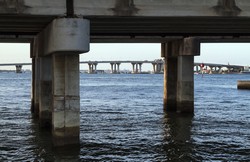Technology to better monitor and assess large concrete bridges
Concrete is the construction material of choice for bridges, but the majority require reinforcement in the form of steel bars and tendons to increase load-bearing capacity. When cracks develop in the concrete and water seeps in, the water can corrode steel reinforcements. As the loads continue to rise compared to the original specifications, the need for sensitive and accurate non-destructive testing (NDT) methods and structural health monitoring technologies has become more pressing. The EU-funded CROSS-IT (Smart condition monitoring and prompt NDT assessment of large concrete bridge structures) project set out to develop novel technology to address this need. Project partners developed an efficient and cost-effective monitoring technology based on ground-penetrating radar (GPR) to locate internal steel-reinforcing bars. They also developed ultrasonic guided waves (UGWs) to inspect the steel reinforcements of concrete structures. Researchers modelled UGWs in concrete and tendons and identified optimum propagation modes through the interface among concrete, steel reinforcement and tendons. They selected UGW transducers to propagate the modes determined from modelling and experiments. The CROSS-IT team developed, tested and validated an integrated system software to automatically detect defects. They advanced software and hardware to combine the GPR and UGW signals in order to display results to the operator. CROSS-IT's system significantly reduces inspection time compared to existing inspection methods. Further, UGW use allows for a much greater inspection range from one single location than previously achieved. It will also minimise the need for corrective maintenance, leading to a significant decrease in overall operational costs. Project outcomes could one day revolutionise bridge inspection and maintenance procedures, all the while enhancing the safety of EU citizens.
Keywords
Concrete bridges, non-destructive testing, CROSS-IT, ground-penetrating radar, ultrasonic guided waves

